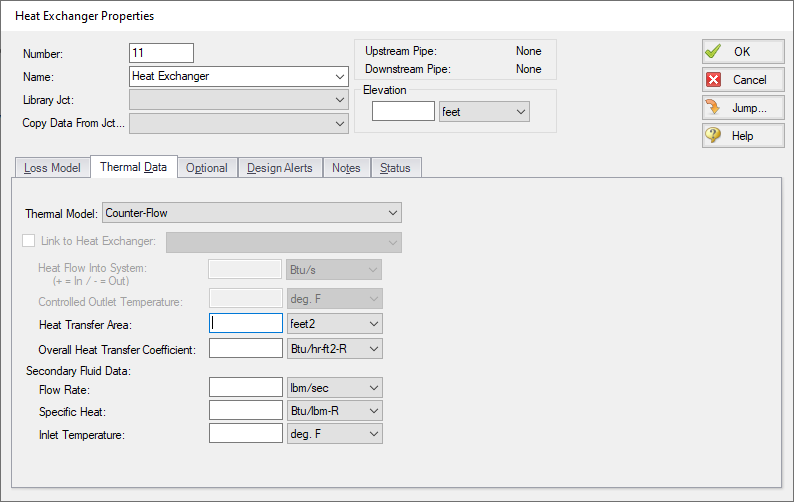Heat Exchanger Heat Transfer
There are twelve different heat exchanger models available in AFT Arrow.
-
NTU-Effectiveness Models
-
Counter-Flow
-
Cross Flow, Both Fluids Unmixed
-
Cross Flow, Secondary Fluid Mixed
-
Cross Flow, System Fluid Mixed
-
Parallel
-
Shell & Tube, 1 Shell Pass, Mult. of 2 Tube Passes
-
-
Directly specified thermal property
-
Controlled Downstream Temperature
-
Controlled Downstream Temperature (Stagnation)
-
Enthalpy Stagnation Rise
-
Specified Heat Rate In Constant
-
Specified Heat Rate In vs. Flow
-
Temperature Stagnation Rise
-

Figure 1: Heat Exchanger Thermal Data
All of the NTU-Effectiveness models require the same 5 parameters as input (shown in Figure 1), but calculate the resulting heat transfer slightly differently. The direct specification models only require that the associated property be entered.
Thermal results are displayed along with pressure results in the Heat Exchanger Summary in the output, as well as information on secondary fluid conditions and log mean temperature difference.
NTU-Effectiveness Method
The NTU-Effectiveness method is used when the fluid inlet and outlet temperatures for the heat exchanger are not known.
To start, the NTU-Effectiveness method requires that the maximum possible heat transfer be found. Theoretically, the maximum heat transfer would occur in a counterflow heat exchanger of an infinite length. In this scenario, the maximum possible temperature difference is the difference between the inlet temperature of the hot fluid and the inlet temperature of the cold fluid:
The minimum heat capacity rate can then be found by multiplying the mass flow rate by the specific heat for the hot fluid and the cold fluid:
The fluid with the higher heat capacity rate changes temperature more quickly along the length of the heat exchanger, but the fluid with the lower heat capacity rate actually sees the maximum possible temperature change. Based on this, the maximum heat transfer between the two fluids in the theoretical heat exchanger is the minimum heat capacity rate multiplied by the maximum temperature difference:
The effectiveness of a heat exchanger is the ratio between the actual heat transfer rate and the maximum possible heat transfer rate:
If the effectiveness and the inlet conditions are known, the amount of heat transferred between the two fluids can be calculated without knowing anything about either fluid’s outlet temperature:
The key to the NTU method becomes calculating the effectiveness, which is a function of the heat capacity ratio, C, and the number of transfer units, NTU:
Each heat exchanger configuration has a unique relation used to calculate the effectiveness. These become the fundamental equations for the six thermal models that use the NTU method:
When modeling convective heat exchangers (such as parallel or counterflow) two heat exchanger junctions can be linked thermally.
A thermal link is when two heat exchanger junctions, which are hydraulically isolated, can exchange heat with each other. Typical use is when the two heat exchangers represent two sides of the same physical heat exchanger. When thermal linking is specified in a heat exchanger Specifications window, the user must specify the heat transfer area and overall convection coefficient. AFT Arrow will force the two heat exchanger junctions to use the same value.
Related Topics



